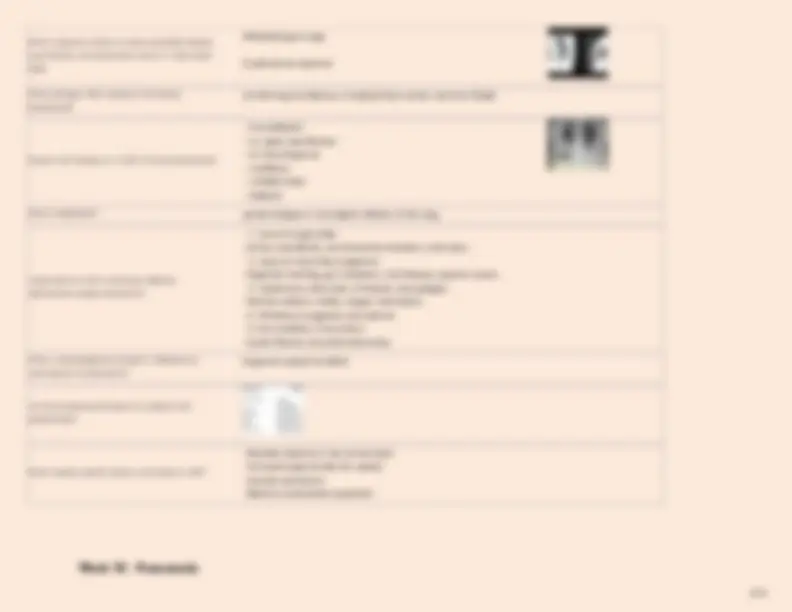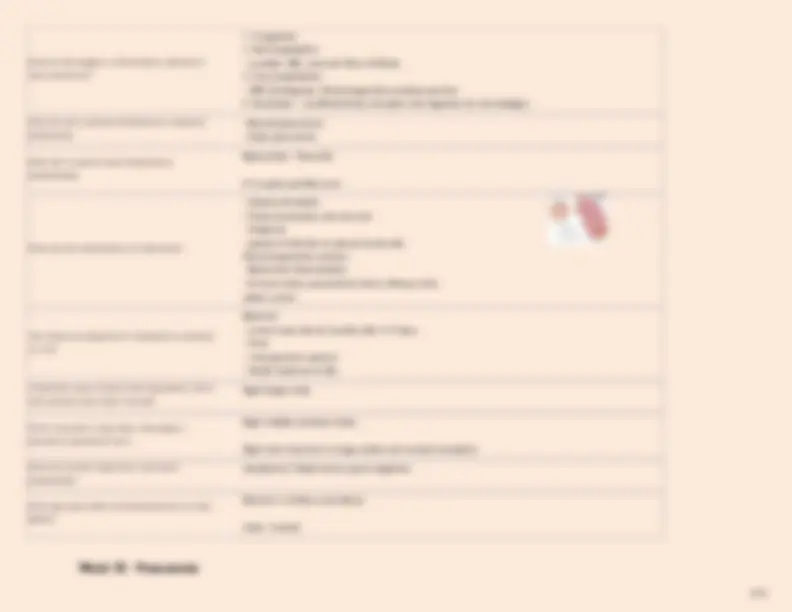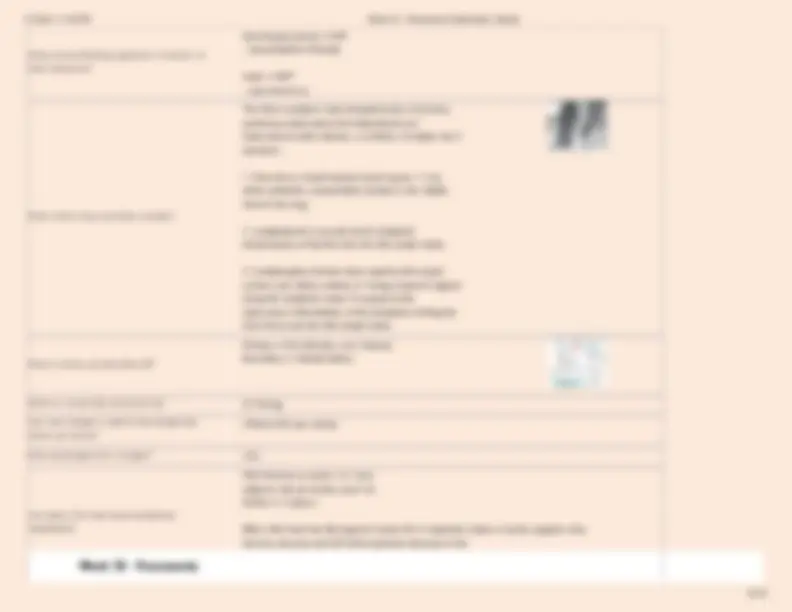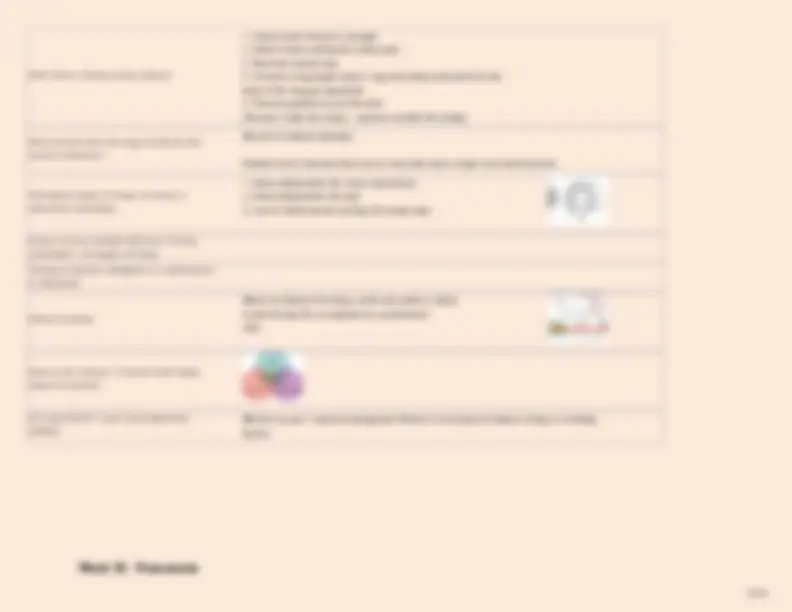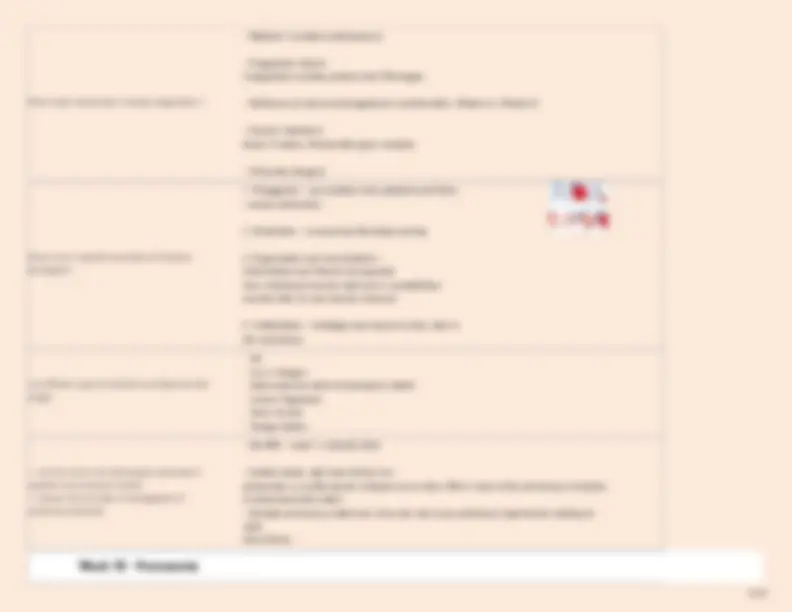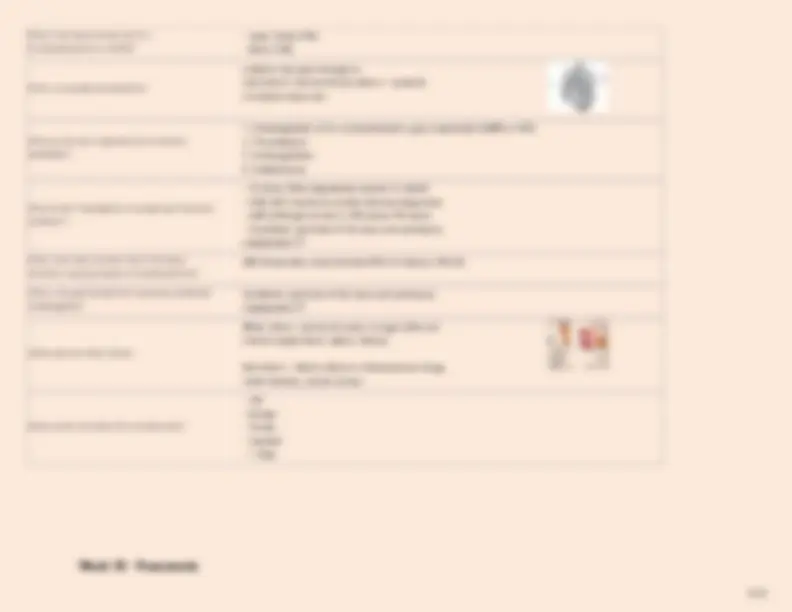Download Pneumonia Exam Review Questions and Answers: Week 10 and more Exams Nursing in PDF only on Docsity!
Week 10 – Pneumonia Exam Review Questions And Answers 2024
Terms in this set (94)
What is the most common organisms causing pneumonia? how does CAP differ for HAP? Strep. Pneumonia is most common in CAP and HAP - accounts for 10-15% List 5 mechanisms maintain a sterile respiratory tract?
- Particles >10μM filtered nasal hairs
- Ciliated lining with mucous
- Cough reflex
- Normal flora of oropharynx
- Mucosal IgA
- Phagocytic cells - alveolar, interstitial, intravascular
- Cell-mediated immunity
Week 10 - Pneumonia
Week 10 - Pneumonia Define CAP, HAP and IAP
- CAP: Community-acquired pneumonia*:
- not been hospitalised recently (or for <48 hrs) and no regular exposure to the health-care system.
- HAP: Hospital-acquired pneumonia:*
48 hours after hospital admission and not incubating at the time of admission.
- IAP: Institution-acquired pneumonia or Healthcare associated pneumonia HCAP:*
- non-hospitalised patient with extensive healthcare contact. E.g. - Rx last 30 days, aged-care facility resident, ≥ 2d hospitalisation days in last 90 days, hospital/dialysis attendance What organism causes the prototype of atypical bacterial pneumonia in CAP? Mycoplasma pneumonia (20%) Also:
- Chlamydophila pneumoniae (Chlamydia pneumoniae) (5-10% CAP),
- Legionella pneumophila (rare but 16% of CAP requiring hospitalisation) What organism causes 'bird fancier's lung' (^) Chlamydophila psittaci What percentage of CAP cases are causes by S. pneumonia? what other bacterial and viral organisms are common? only 10-15% cases. Bacterial: M. pneumoniae, C. pneumoniae, Legionella spp., H. influenzae, S. aureus, Gram negative bacilli. Viral: Influenza virus, influenza virus predominates; other viral aetiologies include RSV, parainfluenza viruses, hMPV, adenovirus, coronaviruses and rhinoviruses What organisms can cause pneumonia in tropical australia? Burkholderia pseudomallei, Acinetobacter baumanii
Week 10 - Pneumonia What are the most common viruses that cause pneumonia?
- Influenza virus A, B;
- Respiratory Syncitial Virus (RSV);
- Parainfluenza viruses 1,2 and 3;
- Adenovirus,
- human Metapneumovirus (hMPV),
- coronaviruses,
- rhinovirus. What are the risk factors for viral pneumonia? Children <2 yrs, adults >65 yrs, chronic disease, immunosuppression, pregnancy, obesity, Aged Care Facility How is viral pneumonia Dx? (^) PCR, viral culture, ag-detection assays What is a serious complication of viral pneumonia? (^) Secondary bacterial infection with S. Aureas→ high mortality What investigations should be completed for CAP?
- CXR
- Sputum (quality important) microscopy and culture
- Blood culture;
- Urine antigen test for Pneumococcus and for Legionella pneumophilla serotype 1
- PCR testing for Mycoplasma pneumoniae, Chlamydophila pneumoniae, Respiratory viruses;
- serology. What is PSI (^) Pneumonia Severity Index. Explain the use of CURB- 65 in Ax of pneumonia Explain the concept of SMART-COP in assessing pneumonia severity
Week 10 - Pneumonia List 5 mechanisms of resistance to antibiotics
- Exclusion of antibiotic from the target-binding site. E.g. Penicillin and Gram - ve bacteria, aminoglycosides and streptococci
- Antibiotic inactivation
- Enzymes cleave or modify drug •e.g. β-lactamases
- Alter drug target/binding site - E.g. Alteration of PBP (binding target site for penicillin) in MRSA
- Remove drug from cell - Active Efflux
- Bypass drug action •Use alternative metabolic pathway to bypass effect of drug - E.g. sulfonamide resistant bacteria use preformed folic acid (instead of needing folic acid precursor) Why do we define HAP differently to CAP?
- Bacteria more likely to be resistant if preceding antibiotic exposure/health-care exposure
- Multidrug resistant gram-negative bacilli are an important cause of HAP, VAP, and HCAP. What is the definition of multi-drug resistant Gram negative bacilli? Resistance to at least two, three, four, or eight of the antibiotics typically used to treat What is the definition of Extensively-drug resistant (XDR) Gram negative bacilli? resistance to all commonly used systemic antibiotics except colistin, tigecycline, and aminoglycosides
Week 10 - Pneumonia How do glucocorticoids work? How does high dose therapy contribute to risk of pneumonia? bind block promotor sites of proinflammatory genes e.g. IL- 1
- Promote transcription of antininflammatory genes e.g. IL-10, I-Kappa-B,
- Stops cytokines from being produced as well as inhibiting their secretion e.g. IL-2, IL-8, TNFa
- Affects the innate immune cells: o Prevents neutrophil apoptosis - reduces their adhesion to endothelial walls as well as reducing neutrophil migration into tissue → therefore would see higher number of circulating neutrophils on FBC o Promotes eosinophil apoptosis o Decreases macrophage production o Decreases mast cell production o Decreases basophil production What is bronchiectasis?
- Permanent dilation of the bronchial lumina associated with destruction of bronchial wall and inflammation
- End-stage change of a variety of disorders o Obstructive
- Neoplasm, foreign body, localized inflammatory process, inspissated (thick) secretions, extended compression o Non-obstructive (post-inflammatory)
- Repeated episodes of pneumonia, Kartagener's syndrome (immotile cilia)
- Complications (uncommon) o Bronchopleural fistula o Emphysema o Brain abscess o Amyloidosis What are the CXR findings in lobar pneumonia? •Confined to a lobe in early stage. •Limited by fissure/s. •Alveolar air space consolidation. •Characterised by air space opacificationwith air-bronchograms. •Some organisms give particular patterns. •Cant make a microbiology diagnosis from Xraysbut can be suggestive. Compare the onset, duration, sputum, chest symptoms of BACTERIAL VS VIRAL Pneumonia
Week 10 - Pneumonia Which organism tends to cause expanded bulging lung fissures, and particularly occurs in right upper lobe Klebsiella (gram neg) Could also be staph etc What pathogen often causes an cavitating pneumonia normal lung architecture is replaced by a cavity←necrosis←Staph Explain the findings on a CXR of bronchopneumonia
- Consolidation
- air space opacification
- air bronchograms
- multifocal
- multiple lobes
- bilateral What is atelectasis? (^) partial collapse or incomplete inflation of the lung. Impairment of which pulmonary defence mechanisms causes pneumonia? •1. Loss of cough reflex
- Coma, anaesthesia, neuromuscular disorders, chest pain •2. Injury to mucociliary apparatus
- Cigarette smoking, gas inhalation, viral diseases, genetic causes •3. Interference with action of alveolar macrophages
- Alcohol, tobacco smoke, oxygen intoxication •4. Pulmonary congestion and oedema •5. Accumulation of secretions
- Cystic fibrosis, bronchial obstruction What is haematogenous spread in reference to transmission of pneumonia? Organism spread via blood List the symptoms and signs for a patient with pneumonia? What hospital specific factors contribute to HAP?
- Resistant bacteria in the environment
- Increased opportunities for spread
- Invasive procedures
- Bacteria contaminate equipment
5/19/24, 11:04 PM Week 10 - Pneumonia Flashcards | Quizlet positive intra thoracic pressure (opposite to normal hence paradox). What are the offending organisms in broncho- vs lobar pneumonia? bronchopneumonia = CAP
- haemohphilis influenza Lobar = HAP
- pneumococcus What is Ghon Focus and Ghon complex? The Ghon complex= macroscopical lesion of primary pulmonary tuberculosis from Mycobacterium tuberculosis initial infection, in children. Complex has 3 elements :
- Ghon focus =small nodular lesion (aprox. 1 cm), white-yellowish, encapsulated, located in the middle third of the lung.
- Lymphadenitis is caused by the lymphatic dissemination of bacillus into the hilar lymph nodes
- Lymphangitis, discrete linear opacity with erased contour and miliary nodules in "string of pearls" aligned along the lymphatic vessel. It represents the tuberculous inflammation of the lymphatics linking the Ghon focus and the hilar lymph nodes What is primary and secondary TB? Primary = first infection, non-immune Secondary = infected before What is a normal tidal volume per kg? (^6) - 7ml/kg How much Oxygen is used by the average size person per minute? 250ml of O2 per minute What percentage of air is oxygen? (^) 21% How does a flail chest cause paradoxical respiration? Flail chest occurs when 2 or more adjacent ribs are broken, each rib broken in 2 places. With a flail chest the flail segment moves IN in inspiration drawn in by the negative intra thoracic pressure and OUT with expiration because of the Week 10 - Pneumonia
Week 10 - Pneumonia What are the 3 types of accessory muscles used on INSPIRATION?
- External intercostal muscles (pull ribs upward and forwards)
- Scalene muscles (elevate the first 2 ribs)
- Sternocleidomastoid muscle (elevates the sternum) What are the EXPIRATORY accessory muscles?
- Abdominal wall muscles (rectus abdominus, internal and external obliques and transversals push the diaphragm up) 2.Internal intercostal muscles (pull the ribs down and in). Why is the tripod position used by patients with COPD? optimizes use of the accessory muscles to facilitate breathing What are the 3 pressure required to keep the lungs expanded in the thoracic cavity?
- Atmospheric
- Inta-Alveolar
- Intra-Pleural What is Atelectasis? PARTIALLY Collapsed lung. or incompletely inflated... Explain how the pressures in the lung/pleura change during pneumothorax What determines the lung's size at rest? the balance between the chest wall trying to expand and the lung trying to contact And if elastic recoil of the lung reduced (as in emphysema), what would happen? Lung size would increase→barrel chest If elastic recoil was increased (e.g. pulmonary fibrosis) what effect would this have on lung size? Lung size would decrease→↓total lung capacity What forces cause the lungs to deflate? 1.^ Elastic properties of lung connective tissue
- Surface tension in the alveoli
Week 10 - Pneumonia What Factors influence airway potency?
- Inherent wall structure/strength
- Elastic tissues pulling the airway open
- Bronchial muscle tone
- Gravity (a lung weighs about 1 kg and airways and alveoli at the base of the lung get squashed)
- Pressure gradient across the wall. (Pressure inside the airway - pressure outside the airway) What structure within the lungs provide the main source of resistance? Bronchi of medium diameter Smallest aren't, because there are so many they have a large cross sectional area Pathological causes of airways narrowing in obstructive lung disease
- Abnormality within the lumen (secretions)
- Abnormality within the wall.
- Loss of radial traction pulling the airway open Review currently accepted definitions of being underweight, overweight and obese Distinguish between maldigestion vs malabsorption vs malnutrition Define thrombosis Blood constituents forming a solid mass within a blood vessel (during life, as opposed to a postmortem clot) What are the 3 factors in Virchows Triad? Relate these to thrombosis Why does Warfarin cause hypercoagulability initially? Warfarin causes ↓ natural anticoagulant (Protein C and protein S) before acting on ↓clotting factors
What is the most common site of origin of a DVT pulmonary embolism? What blood components increase coagulability?
- Platelets: ↑numbers/adhesiveness
- Coagulation factors ↑coagulation cascade proteins and ↑fibrinogen
- Deficiency of natural anticoagulants:↓ antithrombin, ↓Protein C, ↓Protein S
- Genetic mutations: Factor V Leiden, Prothrombin gene mutation
- (Viscosity changes) What is the 4 possible outcomes of thrombus formation?
- Propagation - accumulates more platelets and fibrin, →vessel obstruction.
- Dissolution - removed by fibrinolytic activity.
- Organisation and recanalisation - inflammation and fibrosis incorporated into a thickened vascular wall and/or reestablishes vascular flow via new vascular channels
- Embolisation - dislodges and travels to other sites in the vasculature. List different types of embolism and describe their origin. ¨ fat ¨ air or nitrogen ¨ atherosclerotic debris (cholesterol emboli) ¨ tumour fragments ¨ bone marrow ¨ foreign bodies
- List the clinical and pathological outcomes of systemic and pulmonary emboli.
- Discuss the principles of management of pulmonary embolism
- 60 - 80% - small → clinically silent
- Sudden death, right heart failure (cor pulmonale), or cardiovascular collapse occurs when 60% or more of the pulmonary circulation is obstructed with emboli
- Multiple pulmonary emboli over time also may cause pulmonary hypertension leading to right heart failure. Week 10 - Pneumonia
- Understand how mucus clearance is impaired in smokers' lungs
- Understand the coughing mechanism
- Understand why the pleural space is important particularly in relation to disease states.
- Understand the principles of the "bellows".
- Describe "accessory breathing" and its clinical application.
- Understand how the pressures generated in the pleural space are generated in the breathing cycle.
- Describe the role of surface tension in breathing and relate this to Neonatal Respiratory Distress Syndrome.
- Know the main elements of Lung Function Tests and their clinical relevance. Why is morphine contraindicated in respiratory illness? Opioids cause respiratory depression. Low dose or not used. Consider ?ketamine instead




